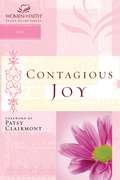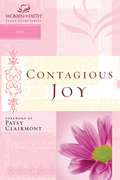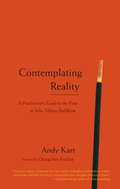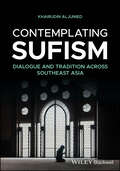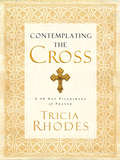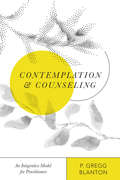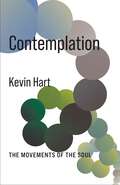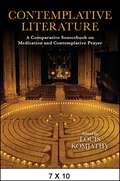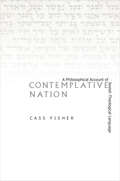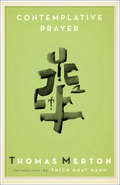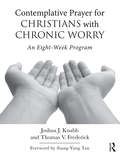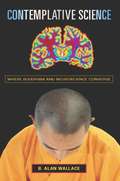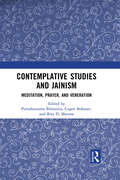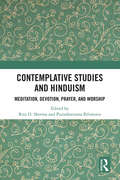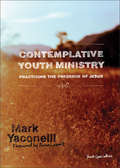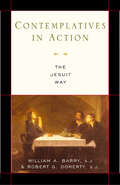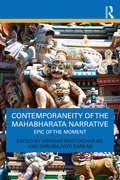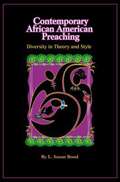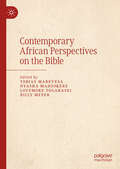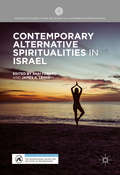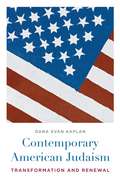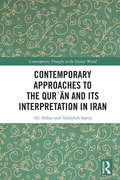- Table View
- List View
Contagious Joy
by Christa KindeWomen of Faith, renowned for their unique combination of personality and truth, offer fresh new messages in their fourth series of popular topical study guides. Titles include:Receiving God's GoodnessExperiencing Spiritual IntimacyContagious JoyUnderstanding PurposeEach study guide, teeming with insights and quotes from the conference speakers provides twelve weeks of Bible study, a leader's guide for small groups, and a special take-home reminder for each week's lesson.
Contagious Joy: Women of Faith Study Guide Series (Women of Faith Study Guide Series)
by Women Of Faith Christa J. KindeWomen of Faith, renowned for their unique combination of personality and truth, offer fresh new messages in their fourth series of popular topical study guides. Titles include: Receiving God's Goodness Experiencing Spiritual Intimacy Contagious Joy Understanding Purpose Each study guide, teeming with insights and quotes from the conference speakers provides twelve weeks of Bible study, a leader's guide for small groups, and a special take-home reminder for each week's lesson.
Contemplating Reality: A Practitioner's Guide to the View in Indo-Tibetan Buddhism
by Andy KarrThis book is for intermediate and advanced Buddhist practitioners who wish to deepen their understanding by joining practice with study of traditional ideas. It introduces the reader to contemplations that investigate a series of views of reality as they evolved in the Buddhist tradition. These views are explained in plain English, with contemporary metaphors and examples to bring out their meaning for modern Buddhists. Quotations from both historical and living meditation masters and scholars are presented as examples of key principles. Topics include * Egolessness * Appearances and reality * Methods of investigation * Enlightenment * Tenets of different schools through the centuries * The root of compassion * The origin of thoughtsGuided exercises encourage the reader to trust in experiential understanding through deep contemplation of complex concepts. The book is structured as a guide for the reader's journey.For more information on the author, Andy Karr, visit his blog at http://contemplatingreality.blogspot.com/. For more information about this book, please visit www.contemplatingreality.org.
Contemplating Sufism: Dialogue and Tradition across Southeast Asia
by Khairudin AljuniedContemplating Sufism: Dialogue and Tradition across Southeast Asia "Exploring Sufi sites and seminaries, Professor Aljunied vividly describes how a dialogic tradition facilitated the formation of a Sufi habitus and life form across Muslim-majority Southeast Asia. The work deftly articulates the synergies between Sufis and the wider public, showing how such dynamics infused increasingly powerful mediums and popular forms of mass mobilization during the colonial and post-colonial eras."—ARMANDO SALVATORE, Barbara and Patrick Keenan Chair in Interfaith Studies, McGill University, Canada "At once personal and scholarly, this book shows how Sufis were engaged in dual dialogues—with themselves and their surroundings—that made them agents of social change in Southeast Asia's past and present alike. Paying equal attention to devotion and miracles, and no less, the political and martial aspects of Sufi activism, Aljunied explains why Islam remains so important in the region today."—NILE GREEN, Ibn Khaldun Endowed Chair in World History, University of California, Los Angeles "Splendidly written and accessible, Khairudin Aljunied tells a lively and engaging story of Muslim piety, metaphysics, and politics as an integral part of Islamic thought and practice in Southeast Asia. Readers will gain a profound and nuanced understanding of Islam in a region with the world’s largest Muslim population. A compelling read!"—EBRAHIM MOOSA, Mirza Family Professor of Islamic Thought and Muslim Societies, University of Notre Dame, USA Contemplating Sufism employs a unique "contemplative histories" methodology to uncover how and why Sufis employed creative mediums to embed and sustain their importance in the region for many centuries. Recognizing Sufism as a dialogical tradition, Khairudin Aljunied reveals the emotional, institutional, and political forces that continue to influence Sufi thought and practices. Providing an accessible and coherent synthesis of the latest scholarship in the field, this innovative study integrates data from around the world, vignettes and anecdotes of Southeast Asian Sufism, and the author's ethnographic observations and personal experiences. Lively and engaging chapters contain vivid descriptions and rich analyses of the texts, ideas, people, practices, and institutions that aided in the development of Sufism—and transformed Southeast Asia’s ideological, cultural, political, and social landscapes. Illustrating the inventiveness and energy of the Sufis, Contemplating Sufism: Dialogue and Tradition across Southeast Asia is an excellent textbook for undergraduate and graduate courses on Sufism and a valuable resource for academics, scholars, and general readers with an interest in the mystical dimension of Islam in the non-Arab world.
Contemplating the Cross
by Tricia Mccary RhodesFew times of year lend themselves to pilgrimage and contemplation like Easter. For forty days, Christians have before them the opportunity to examine their own path and compare it with the incredible journey undertaken by Christ, from the agony of the garden to the glory of the resurrection. By sharing her journey, Tricia Rhodes provides the tools to cultivate the cross within and the inspiration to accept the Father's summons to kneel in its shadow. Scripture and daily exercises gently nourish the spiritual traveler, while journal pages wait to hold the story of personal reflection.More encompassing than a devotional, more intimate than a mere yardstick of faith, Contemplating the Cross will become a treasured keepsake."May God touch your deepest soul and brand you with the fire of His devotion as you contemplate the cross of Christ." Tricia Rhodes
Contemplation and Counseling: An Integrative Model for Practitioners (Christian Association for Psychological Studies Books)
by P. Gregg BlantonInterest in mindfulness and contemplative thought is growing among Christians, and it's time to consider the place of contemplative prayer within the field of counseling. Can contemplative prayer be integrated into therapeutic work? Can it in fact serve as a foundation on which to build a new approach to counseling? In Contemplation and Counseling Gregg Blanton presents a new paradigm for integrating contemplative prayer with counseling practice. He contends that contemplative prayer can illuminate the purposes of counseling and suggest interventions that help us accomplish these goals. This paradigm builds an alliance between science, theology, and Christian contemplative thought to create a dynamic approach to counseling and balance various dimensions of the human person: emotion, cognition, and action. And by recognizing the power of both words and silence, it harmonizes their functions. Based on this integrative foundation, Blanton offers eleven fundamental interventions to fit the needs of clients (including silence, empathy, and teaching contemplative prayer) and a practical four-stage process for helping clients change, using examples from his own counseling experience and from the Bible. Ultimately, contemplative prayer leads us to the healing power of love. How we view our clients, the ways that we relate with them, and the strategies that we use to help them change are all informed by our loving search for God in contemplative prayer. Particular topics include how Christian contemplation compares with therapeutic uses of mindfulness insights from interpersonal neurobiology understood in light of Scripture psychological and spiritual benefits of lectio divina and centering prayer how practicing contemplative prayer can help counselors develop traits that correlate with positive client outcomes when and how to teach contemplative practices to clients the role of the body, emotions, conscious and unconscious mind, and behavior in contemplative practice and counseling
Contemplation: The Movements of the Soul (No Limits)
by Kevin HartWhat is contemplation? How is it distinct from meditation? Is contemplation essentially religious or mystical? What should one contemplate, and how? Are there different styles of contemplation, and why should one practice them? Ought we try to lead more contemplative lives?This book offers a philosophical introduction to the theory and practice of contemplation. Kevin Hart examines a variety of religious, aesthetic, and philosophical notions, shedding light on the singular qualities of contemplation. This book spans topics including the spiritual exercises of the ancient Greeks, overlooked aspects of Christian spirituality, and aesthetic contemplation of nature and art. Contemplation ranges from ancient thinkers such as Aristotle, Plato, and Plotinus to Aquinas and other medieval theologians as well as modern philosophers like Kant, Husserl, and Wittgenstein. Though focused on Christianity, it also considers contemplation in other religious traditions, among them Buddhism, Hinduism, Judaism, Islam, and Paganism.Concise and comprehensive, this book provides both religious and nonreligious readers with a foundational understanding of the history and nature of contemplation as well as the benefits of practicing it.
Contemplative Literature: A Comparative Sourcebook on Meditation and Contemplative Prayer
by Louis KomjathyThis is the first theoretically informed and historically accurate comparative anthology of primary texts on meditation and contemplative prayer. Written by international experts on the respective texts and corresponding traditions, Contemplative Literature provides introductions to and primary sources on contemplative practice from various religious traditions. The contributors explore classical Daoist apophatic meditation, Quaker silent prayer, Jewish Kabbalah, Southern Buddhist meditation, Sufi contemplation, Eastern Orthodox prayer, Pure Land Buddhist visualization, Hindu classical Yoga, Dominican Catholic prayer, Daoist internal alchemy, and modern therapeutic meditation. Each introduction to a contemplative text discusses its historical context, the associated religious tradition and literature, the method of contemplative practice, and the text's legacy and influence. Volume editor Louis Komjathy opens the work with a thoughtful consideration of interpretive issues in the emerging interdisciplinary field of contemplative studies. Readers will gain not only a nuanced understanding of important works of contemplative literature, but also resources for understanding contemplative practice and contemplative experience from a comparative and cross-cultural perspective.
Contemplative Nation: A Philosophical Account of Jewish Theological Language
by Cass FisherContemplative Nation challenges the long-standing view that theology is not a vital part of the Jewish tradition. For political and philosophical reasons, both scholars of Judaism and Jewish thinkers have sought to minimize the role of theology in Judaism. This book constructs a new model for understanding Jewish theological language that emphasizes the central role of theological reflection in Judaism and the close relationship between theological reflection and religious practice in the Jewish tradition. Drawing on diverse philosophical resources, Fisher's model of Jewish theology embraces the multiple forms and functions of Jewish theological language. Fisher demonstrates the utility of this model by undertaking close readings of an early rabbinic commentary on the book of Exodus (Mekhilta of Rabbi Ishmael ) and a work of modern philosophical theology (Franz Rosenzweig's The Star of Redemption). These readings advance the discussion of theology in rabbinics and modern Jewish thought and provide resources for constructive Jewish theology.
Contemplative Prayer (Image Classics Ser.)
by Thich Nhat Hanh Thomas MertonIn this classic text, Thomas Merton offers valuable guidance for prayer. He brings together a wealth of meditative and mystical influences-from John of the Cross to Eastern desert monasticism-to create a spiritual path for today. Most important, he shows how the peace contacted through meditation should not be sought in order to evade the problems of contemporary life, but can instead be directed back out into the world to affect positive change.Contemplative Prayer is one of the most well-known works of spirituality of the last one hundred years, and it is a must-read for all seeking to live a life of purpose in today's world.In a moving and profound introduction, Thich Nhat Hanh offers his personal recollections of Merton and compares the contemplative traditions of East and West.From the Trade Paperback edition.
Contemplative Prayer for Christians with Chronic Worry: An Eight-Week Program
by Joshua J. Knabb Thomas V. FrederickContemplative Prayer for Christians with Chronic Worry presents an eight-week approach for working with recurrent worry. Each chapter offers an introduction for the week, goals, techniques, and homework. Six free audio recordings are also available to download for use when practicing the guided meditations. Clinicians and their clients will find that the workbook helps them explore ways to lessen daily worries through contemplative prayer. Relying on scriptural support, the contemplative Christian tradition, and psychological science, clients will learn how to sit in silence with God, trusting in him during moments of uncertainty, worry, and anxiety.
Contemplative Science: Where Buddhism and Neuroscience Converge
by B. Alan Wallace Brian HodelB. Alan Wallace, renowned Buddhist scholar, integrates the contemplative methodologies of Buddhism and Western science into a single discipline: contemplative science. The science of consciousness investigates the mind through Buddhist contemplative techniques, such as shamatha, an organized, detailed system of training the attention. Just as scientists make observations and conduct experiments with the aid of technology, contemplatives have long tested their theories with the help of highly developed meditative skills of observation and experimentation. Contemplative science allows for a deeper knowledge of mental phenomena, and its emphasis on strict mental discipline counteracts the effects of conative (intention and desire), attentional,cognitive, and affective imbalances. Just as behaviorism, psychology, and neuroscience shed light on the cognitive processes enabling us to survive and flourish, contemplative science offers a groundbreaking perspective for expanding our capacity to realize genuine well-being. It also forges a link between the material world and the realm of the subconscious, transcending a traditional science-based understanding of the self.
Contemplative Science: Where Buddhism and Neuroscience Converge (Columbia Series in Science and Religion)
by B. Alan WallaceScience has long treated religion as a set of personal beliefs that have little to do with a rational understanding of the mind and the universe. However, B. Alan Wallace, a respected Buddhist scholar, proposes that the contemplative methodologies of Buddhism and of Western science are capable of being integrated into a single discipline: contemplative science.The science of consciousness introduces first-person methods of investigating the mind through Buddhist contemplative techniques, such as samatha, an organized, detailed system of training the attention. Just as scientists make observations and conduct experiments with the aid of technology, contemplatives have long tested their own theories with the help of highly developed meditative skills of observation and experimentation. Contemplative science allows for a deeper knowledge of mental phenomena, including a wide range of states of consciousness, and its emphasis on strict mental discipline counteracts the effects of conative (intention and desire), attentional, cognitive, and affective imbalances.Just as behaviorism, psychology, and neuroscience have all shed light on the cognitive processes that enable us to survive and flourish, contemplative science offers a groundbreaking perspective for expanding our capacity to realize genuine well-being. It also forges a link between the material world and the realm of the subconscious that transcends the traditional science-based understanding of the self.
Contemplative Studies & Jainism: Meditation, Prayer, and Veneration
by Purushottama Bilimoria Rita D. Sherma Cogen BohanecThis volume is one of the first wide-ranging academic surveys of the major types and categories of Jain praxis. It covers a breadth of scholarly viewpoints that reflect both the variegation in terms of spiritual practices within the Jain traditions as well as the Jain hermeneutical perspectives, which are employed in understanding its rich diversity. The volume illustrates a complex and nuanced understanding of the multifaceted category of Jain religious thought and practice. It offers a rare intrareligious dialogue within Jain traditions and at the same time, significantly broadens and enriches the field of Contemplative Studies to include an ancient, ascetic, non-theistic tradition. Meditation, yoga, ritual, prayer are common to all Indic spiritual traditions. By investigating these diverse, yet overlapping, categories one might obtain a sophisticated understanding of religious traditions that originally emerged in South Asia. Essays in this book demonstrate how these forms of praxis in Jainism, and the philosophies that anchor those practices, are interrelated, and when brought into dialogue, help to foster new tools for understanding a complex and variegated tradition such as Jain Dharma. This book will be useful to scholars and researchers of religious and theological studies, contemplative studies, Jain studies, Hindu studies, consciousness studies, Yoga studies, Indian philosophy and religion, sociology of religion, philosophy of religion, comparative religion, and South Asian studies, as well as general readers interested in the topic.
Contemplative Studies and Hinduism: Meditation, Devotion, Prayer, and Worship
by Rita D. Sherma; Purushottama BilimoriaThis book is one of the first wide-ranging academic surveys of the major types and categories of Hindu contemplative praxis. It explores diverse spiritual and religious practices within the Hindu traditions and Indic hermeneutical perspectives to understand the intricate culture of meditative communion and contemplation, devotion, spiritual formation, prayer, ritual, and worship. The volume extends and expands the conceptual reach of the fields of Contemplative Studies and Hindu Studies. The chapters in the volume cover themes in Hindu contemplative experience from various texts and traditions including classical Sāṃkhya and Patañjali Yoga, the Bhāgavata Purāṇa, the role of Sādhana in Advaita Vedānta, Śrīvidyā and the Śrīcakra, the body in Tantra, the semiotics and illocution of Gauḍīya Vaiṣṇava sādhana, mantra in Mīmāṃsā, Vaiṣṇava liturgy, as well as cross-cultural reflections and interreligious comparative contemplative praxis. The volume presents indigenous vocabulary and frameworks to examine categories and concerns particular to the Hindu contemplative traditions. It traces patterns that cut across Hindu traditions and systems and discusses contrasting methods of different theological/philosophical schools evincing a strong plurality in Hindu religious thought and practice. The volume provides intra-religious comparisons that reveal internal complexity, nuances, and a variety of contemplative states and transformative practices that exist under the rubric of Hindu practices of interiority and reflection. With key insights on forms and functions of the contemplative experience along with their theologies and philosophies, the volume suggests new hermeneutical directions that will advance the field of contemplative studies. This book will be useful to scholars and researchers of religious and theological studies, contemplative studies, Hindu studies, consciousness studies, yoga studies, Indian philosophy and religion, sociology of religion, philosophy of religion, comparative religion, and South Asian studies, as well as general readers interested in the topic.
Contemplative Youth Ministry: Practicing the Presence of Jesus
by Mark Yaconelli“Contemplative Youth Ministry is refreshing rain for dry youth workers and barren youth ministries. More than the same old youth ministry tips and tricks, it gives principles and practices to soak in God’s grace, love, and power. I wish I had read it 15 years ago.” - Kara Powell, Ph.D., executive director, Center for Youth Ministry and Family Ministry, Fuller Theological Seminary “Mark invites readers to be encountered by the presence of Jesus who is always near. This book is transparent about the challenges that churches and families face as they desire to be effective in youth ministry. The book is filled with the honest stories of different kinds of youth ministries representing the breadth of Christianity in the United States. I heartily endorse Contemplative Youth Ministry as a rich encounter with the souls of youth and adults whose lives have been transformed by our very present God.” - Bill Kees, director of youth ministries, Evangelical Lutheran Church in America (ELCA) “Mark Yaconelli not only reminds us of some of the long-forgotten pathways of faith, he shares with us how it actually looks when men and women who love God practice it with young people. I especially appreciate Mark’s optimism in his perspective of today’s kids, for his insights are grounded in God’s view of them.” - Chap Clark, Ph.D., associate professor of youth, family, and culture, Fuller Theological Seminary “Mark Yaconelli was experimenting with contemplative youth ministry practices before contemplative youth ministry practices became cool. This book has about it the unique air of authenticity. He shares with us in these pages his own journey as a youth worker who actually believes that God’s still small voice speaks louder than the roaring windstorm of our busy youth ministry calendars. It’s a book about creating for our students places of silence and opening up spaces for God to speak.” - Duffy Robbins, professor of youth ministry, Eastern University; author of Enjoy the Silence and This Way to Youth Ministry “Mark Yaconelli has emerged as one of youth ministry’s most provocative ‘voices in the wilderness,’ calling us back to our theological taproots: The contemplative practices that bind our lives to the life of Christ. If Mark’s research has taught us anything, it’s that these practices do not cause youth ministry to take fl ight into a spiritual never-never land; rather they anchor young people—and their churches—in the fertile soil of Christian tradition, in the nitty-gritty of daily life, and in the explosive transformation that awaits us when we wait upon God.” - Kenda Creasy Dean, parent, pastor, and professor of youth, Princeton Theological Seminary; author of Practicing Passion: Youth and the Quest for a Passionate Church
Contemplatives in Action: The Jesuit Way
by William A. Barry S. J. S.J. and Robert G. DohertyExamines the nature of Jesuit spirituality, which is a spirituality of life-giving and creative tensions.
Contemporaneity of the Mahabharata Narrative: Epic of the Moment
by Anirban Bhattacharjee and Dhrubajyoti SarkarNotwithstanding its renowned comprehensive narrative encapsulation of the Indic culture, the Mahabharata keeps on posing a challenge to its contemporary readers: how do we relate to something over two-millennia old in today’s context without freezing it in time? This volume looks at the problem from diverse periods and standpoints and shows us that this challenge is, in fact, a legacy of the Mahabharata and the responses to this challenge are what makes the text ever-contemporary to different readers of different times and positions.It traces the evolution of the Mahabharata from its inception in the fifth century BCE to twenty-first century, spanning classical Sanskrit tradition, Persian and Bengali adaptations, the Mahabharata as a serialized TV show to more recent graphic narratives. By attempting to analyse this diversity, this volume further delves into how the issues in the Mahabharata resonate across time, from the world of ancient sages to contemporary struggles of women. The essays in this book adopt a dual perspective to appreciate both the Mahabharata’s historical context, its exploration of war, heroes and heroines, gender, psychology, philosophy, and its implications for the future.This book will be of interest to scholars and researchers of Indian literature, ancient literature and philosophy, English literature, cultural studies, visual studies, gender studies, and translation studies.
Contemporary African American Preaching: Diversity in Theory and Style
by L. Susan BondL. Susan Bond reveals the full range and diversity of African American preaching in this exploration of African American homiletical theories. Portraying the many approaches that are empowering preaching in African American churches today, Bond shows how different theological perspectives produce different methods of sermon preparation and delivery, different strategies for selecting illustrative material, and even different ways of beginning and ending sermons. Her goal is not to lift up the "right way" to preach in the African American tradition, but to show the richness and nuance contained within this powerful cultural expression.
Contemporary African Perspectives on the Bible
by Lovemore Togarasei Tobias Marevesa Nyasha Madzokere Billy MeyerThis volume explores current methodological developments in the interpretation of the Bible from an African perspective. Previous scholarship has explored the relevance of Eurocentric biblical interpretive methods to African experiences and contexts. This book furthers the discussion by examining the continuing importance of contextual Bible interpretation. Authors provide an evaluation of the work done by the precursors and predecessors interpreting the Bible from an African point of view, and then analyse the emerging challenges to interpreting the Bible in an ever-changing context. The volume is a comprehensive resource, providing new interpretations of the Bible in Africa, and addressing the contemporary questions of people in Africa and beyond.
Contemporary Alternative Spiritualities in Israel (Palgrave Studies in New Religions and Alternative Spiritualities)
by Shai Feraro and James R. LewisThis volume is the first English-language anthology to engage with the fascinating phenomena of recent surges in New Age and alternative spiritualties in Israel. Contributors investigate how these New Age religions and other spiritualties—produced in Western countries within predominantly Protestant or secular cultures–transform and adapt themselves in Israel. The volume focuses on a variety of groups and movements, such as Theosophy and Anthroposophy, Neopaganism, Channeling, Women’s Yoga, the New Age festival scene, and even Pentecostal churches among African labor migrants living in Tel Aviv. Chapters also explore more Jewish-oriented practices such as Neo-Kabballah, Neo-Hassidism, and alternative marriage ceremonies, as well as the use of spiritual care providers in Israeli hospitals. In addition, contributors take a close look at the state’s reaction to the recent activities and growth of new religious movements.
Contemporary American Judaism: Transformation and Renewal
by Dana Evan KaplanNo longer controlled by a handful of institutional leaders based in remote headquarters and rabbinical seminaries, American Judaism is being transformed by the spiritual decisions of tens of thousands of Jews living in all corners of the United States. A pulpit rabbi and himself an American Jew, Dana Evan Kaplan follows this religious individualism from its postwar suburban roots to the hippie revolution of the 1960s and the multiple postmodern identities of today. From Hebrew tattooing to Jewish Buddhist meditation, Kaplan describes the remaking of historical tradition in ways that channel multiple ethnic and national identities. While pessimists worry about the vanishing American Jew, Kaplan focuses on the creative responses to contemporary spiritual trends that have made a Jewish religious renaissance possible. He believes that the reorientation of American Judaism has been a "bottom up" process, resisted by elites who have only reluctantly responded to the demands of the "spiritual marketplace." The American Jewish denominational structure is therefore weakening at the same time that religious experimentation is rising, leading to innovative approaches that are supplanting existing institutions. The result, as Kaplan makes clear, is an exciting transformation of what it means to be a religious Jew in twenty-first century America.
Contemporary American Judaism: Transformation and Renewal
by Dana KaplanNo longer controlled by a handful of institutional leaders based in remote headquarters and rabbinical seminaries, American Judaism is being transformed by the spiritual decisions of tens of thousands of Jews living all over the United States. A pulpit rabbi and himself an American Jew, Dana Evan Kaplan follows this religious individualism from its postwar suburban roots to the hippie revolution of the 1960s and the multiple postmodern identities of today. From Hebrew tattooing to Jewish Buddhist meditation, Kaplan describes the remaking of historical tradition in ways that channel multiple ethnic and national identities. While pessimists worry about the vanishing American Jew, Kaplan focuses on creative responses to contemporary spiritual trends that have made a Jewish religious renaissance possible. He believes that the reorientation of American Judaism has been a "bottom up" process, resisted by elites who have reluctantly responded to the demands of the "spiritual marketplace." The American Jewish denominational structure is therefore weakening at the same time that religious experimentation is rising, leading to the innovative approaches supplanting existing institutions. The result is an exciting transformation of what it means to be a religious American Jew in the twenty-first century.
Contemporary Approaches to the Qurʾan and its Interpretation in Iran (Contemporary Thought in the Islamic World)
by Abdullah Saeed Ali AkbarThis book sets out how contemporary Iranian scholars have approached the Qurʾān during recent decades. It particularly aims to explore the contributions of scholars that have emerged in the post 1979-revolution era, outlining their primary interpretive methods and foundational theories regarding the reading of the Qurʾān. Examining issues such as the status of women, democracy, freedom of religion and human rights, this book analyses the theoretical contributions of several Iranian scholars, some of which are new to the English-speaking academy. The hermeneutical approaches of figures such Abdolkarim Soroush, Muhammad Mojtahed Shabestari, Mohsen Kadivar, Hasan Yousefi-Eshkevari, Abolqasem Fanaie and Mostafa Malekian are presented and then analysed to demonstrate how a contextualist approach to the Qu’ran has been formed in response to the influence of Western Orientalism. The effect of this approach to the Qu’ran is then shown to have wide-ranging effects on Iranian society. This study reveals Qu’ranic thought that has been largely overlooked by the West. It will, therefore. Be of great use to academics in Religious, Islamic and Qurʾānic studies as well as those studying the culture of Iran and the Middle East more generally.
Contemporary Arab Thought: Cultural Critique in Comparative Perspective
by Elizabeth Suzanne KassabDuring the second half of the twentieth century, the Arab intellectual and political scene polarized between a search for totalizing doctrines-nationalist, Marxist, and religious-and radical critique. Arab thinkers were reacting to the disenchanting experience of postindependence Arab states, as well as to authoritarianism, intolerance, and failed development. They were also responding to successive defeats by Israel, humiliation, and injustice. The first book to take stock of these critical responses, this volume illuminates the relationship between cultural and political critique in the work of major Arab thinkers, and it connects Arab debates on cultural malaise, identity, and authenticity to the postcolonial issues of Latin America and Africa, revealing the shared struggles of different regions and various Arab concerns.
